Find aDomain Search Powered byGoDaddy.com ...
Choose a name that catches the eye but is not too narrow, so you don’t limit your potential subject areas down the line.
We earn commissions if you shop through the links below. Read more
Written by: Carolyn Young
Carolyn Young has over 25 years of experience in business in various roles, including bank management, marketing management, and business education.
Published on June 8, 2022
Updated on December 25, 2022
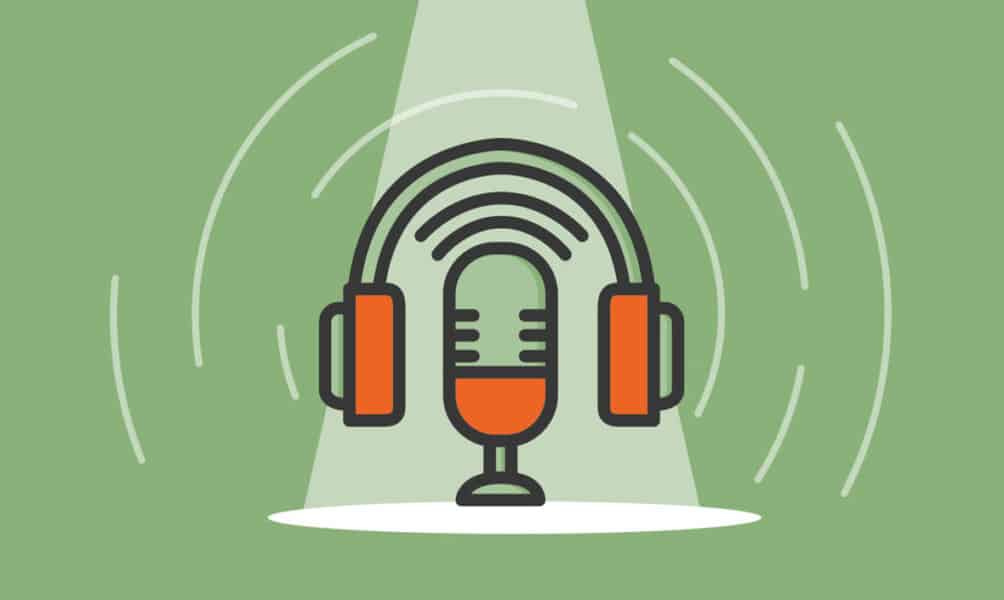
Investment range
$3,550 - $8,100
Revenue potential
$60,000 - $120,000 p.a.
Time to build
1 – 3 months
Profit potential
$54,000 - $108,000 p.a.
Industry trend
Growing
Commitment
Flexible
Podcasts have exploded in popularity in recent years, with more than a third of all Americans listening to at least one in 2021. From comedy and news to interviews, crime and history, podcasts are great to listen to at the gym, in the car, while cooking, or anytime you need a dose of distraction or entertainment.
That’s why podcasts are one of the world’s fastest-growing industries — worth $11 billion globally and expected to see stunning annual growth of more than 30% through 2028. With numbers like that, there is clearly money to be made with a podcast of your own.
But before you start investigating some mysterious local crime, it’s important to understand the entrepreneurial process and the specifics of podcast monetization. Lucky for you, this step-by-step guide lays out all you need to know to develop and launch a lucrative podcast.

Starting a podcast has pros and cons to consider before deciding if it’s right for you.
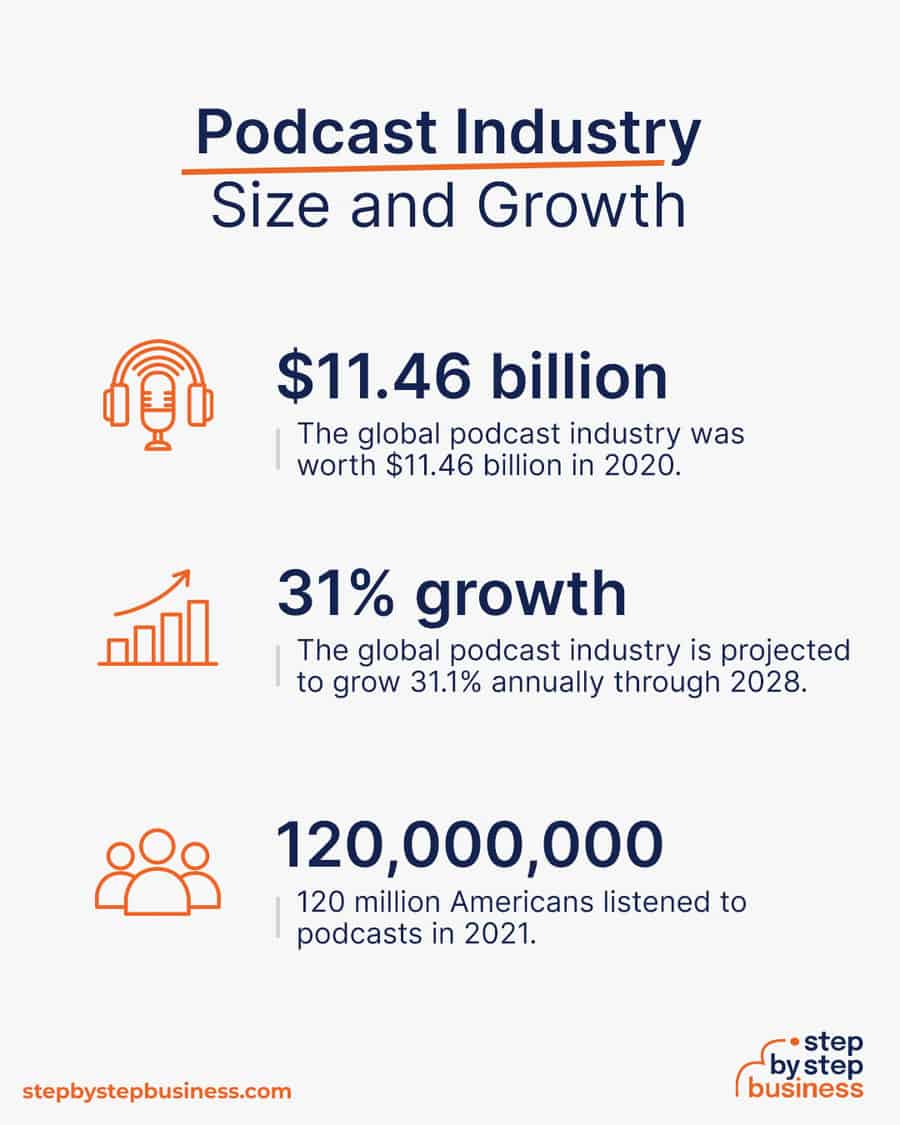
Trends in the podcast industry include:
Challenges in the podcast industry include:
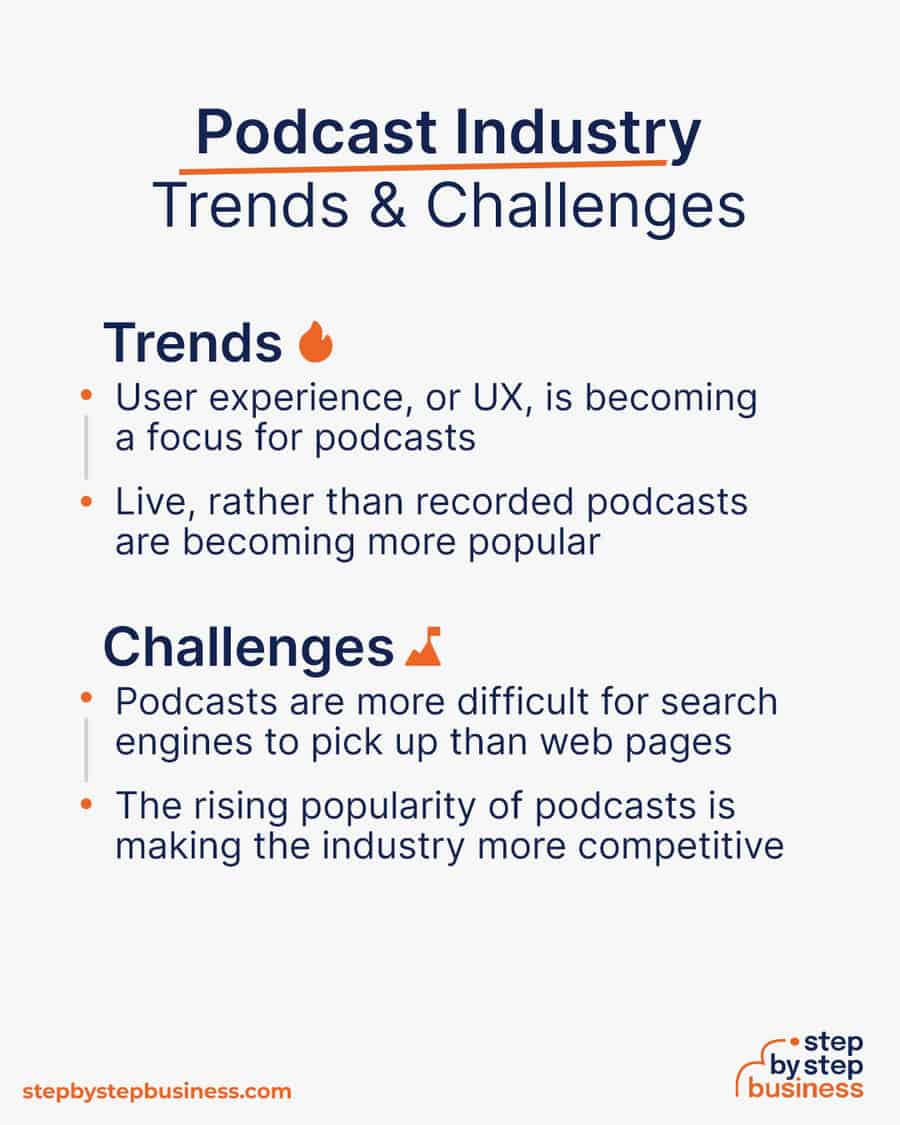
The most popular types of podcasts are:
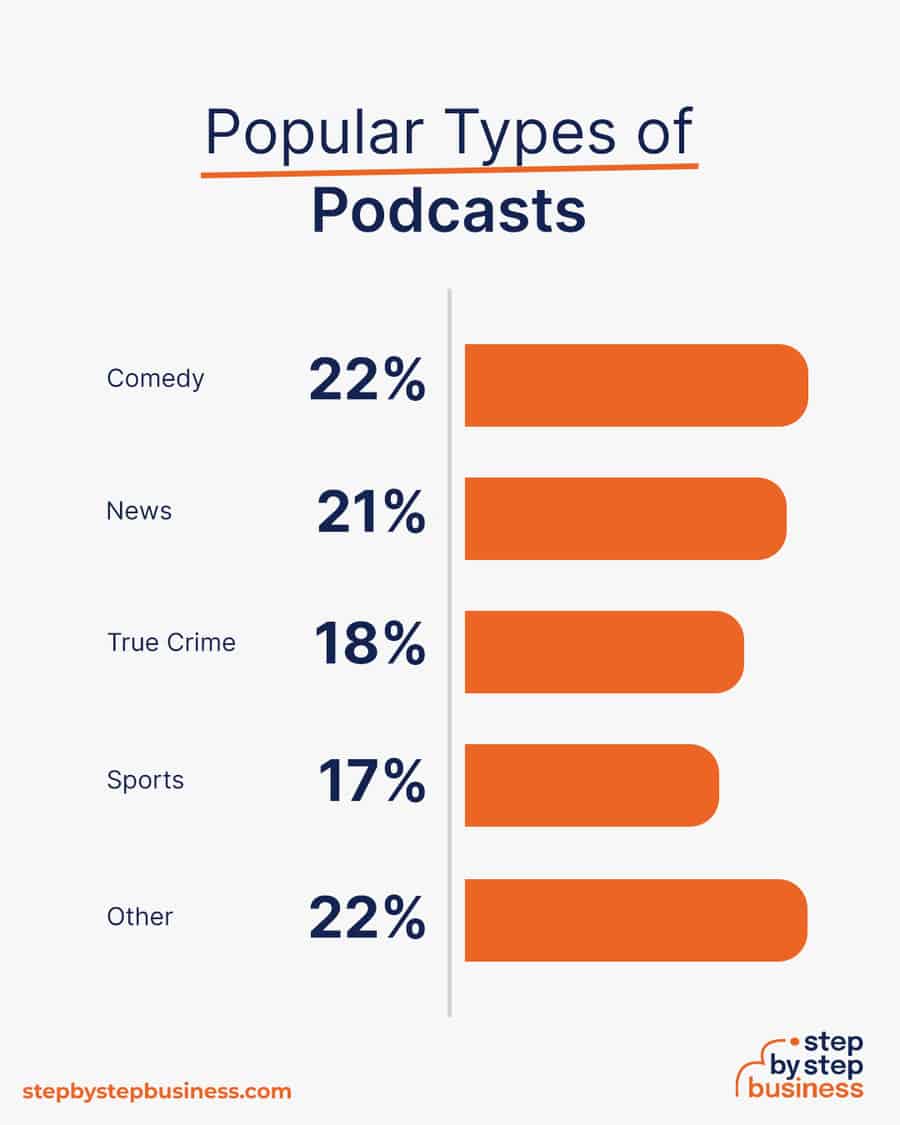
Startup costs for a podcast range from $3,500 to $8,000. Costs include a computer and your other equipment.
You’ll need a handful of items to successfully launch your podcast business, including:
| Start-up Costs | Ballpark Range | Average |
|---|---|---|
| Setting up a business name and corporation | $150 - $200 | $175 |
| Business licenses and permits | $100 - $300 | $200 |
| Insurance | $100-$300 | $200 |
| Business cards and brochures | $200 - $300 | $250 |
| Website setup | $1,000 - $3,000 | $2,000 |
| Computer and equipment | $2,000 - $4,000 | $3,000 |
| Total | $3,550 - $8,100 | $5,825 |
This section will cover the nitty gritty of actually producing your podcast.
First, you’ll need to decide what kind of podcast episodes you’re going to do. It could be anything from comedy to news to something educational. It’s best to choose something that you know a lot about or you’re particularly interested in. It’s also a good idea to choose a topic with real depth, something you can make 100 or more episodes about.
Next, make a list of topics for your first several episodes, and you might want to make outlines as well. Then it’s time to start doing your research and preparing for the recording.
The name you choose for your podcast should of course link to your content and themes.
Choose a name that catches the eye but is not too narrow, so you don’t limit your potential subject areas down the line.
For instance if you’re doing a true crime podcast and your first season is about a series of unsolved killings in York, NY, in the early 1900s, you might want to go with “Turn of the Century Murder” over “The Mystery Killings of York”.
On the other hand, if you’re planning an interview podcast, your title can be a bit more vague. What’s important is that it grabs people’s attention, like “WTF with Marc Maron” or “Smartless”.
Your format is the length of your episodes and the layout and style in which they are presented.
When determining the length, make sure that you have enough engaging content to fill that amount of time. You don’t want to lose someone’s attention in the middle. There is no ideal length of a podcast, so the length will just be based on what you’re talking about.
Keep in mind, you could have a podcast that varies considerably in length, from 26 minutes one episode to 53 minutes in the next. That’s fine — as long as the content is strong.
The style of your podcast could be interviews, talking with a co-host, or just you performing or presenting information.
The layout is how the actual podcast is structured. It might look something like this:
When you get to a certain level of viewers, you’ll also need room for ad space since that’s one of the ways you can make money.
Your cover art is what people will see when scrolling through the podcast directory, so it should be engaging. You can find a freelance designer to help you or you could use a design site like Canva.
If you want to have intro music, try to use something that will appeal to your target audience. You’ll just want short clips of music so that it doesn’t overshadow your podcast content.
Using the equipment and software you purchased, it’s time to start the show! Here are a few software options:
Garage Band is another option that’s free.
Most podcast software also will allow you to edit your podcast as well.
You’ll need a podcast hosting site for your podcast audio files. Sites like Buzzsprout and others are free for a trial period and then you pay a fee, around $12 to $25 per month. You simply sign up and upload your podcast episodes. Some other podcast hosting platforms include:
Submit your podcast to as many podcast directories as you can, from Stitcher and Spotify to Apple Podcast and Google Podcast and Google Play. Your logo and label will appear on those sites, and hopefully, people will start listening! Share your podcast on all your social media and your website to get the word out.
It will take some time to get your podcast to the level of listeners that you’ll need to start making money, but once you get to that point there are several ways to monetize your podcast.
Your income will depend on your podcast downloads. You’ll only be able to attract advertisers when you get a large following of listeners. Advertisers generally pay $20 to $30 per ad per 1,000 downloads, so if you have an ad in an episode that gets 100,000 downloads, you’d make around $2,500. Your profit margin will be high, around 90%.
In your first year or two after you’ve gotten to a certain volume of listeners, you could do two episodes per month, bringing in $60,000 in annual revenue. This would mean $54,000 in profit, assuming that 90% margin. If you start doing weekly episodes, those numbers will double. With annual revenue of $120,000, you’d make a tidy profit of $108,000.
If you do affiliate or merchandise sales, you’ll make even more.
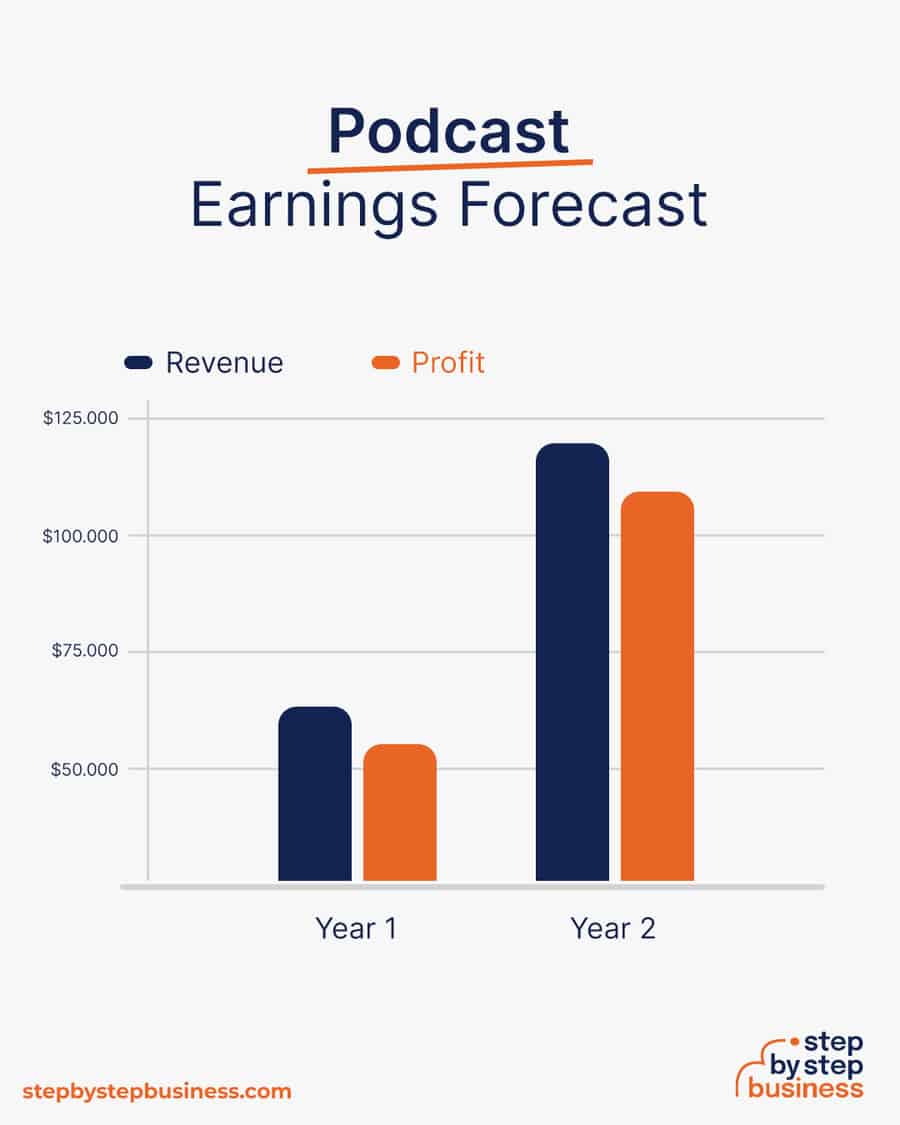
There are a few barriers to entry for a podcast. Your biggest challenges will be:

Now that you know what’s involved in starting a podcast, it’s a good idea to hone your concept in preparation to enter a competitive market.
Research successful podcasts, their content, and customer reviews. You’re looking for a market gap to fill. For instance, maybe the market is missing a podcast that offers a particular style of comedy or a podcast about a specific social issue.
You might consider targeting a niche market by specializing in a certain aspect of your industry, such as sports news or ancient history.
This could jumpstart your word-of-mouth marketing and attract clients right away.
Your target market will depend on your podcast content. If you’re trying to attract a younger audience, you can market your podcast on TikTok or Instagram.
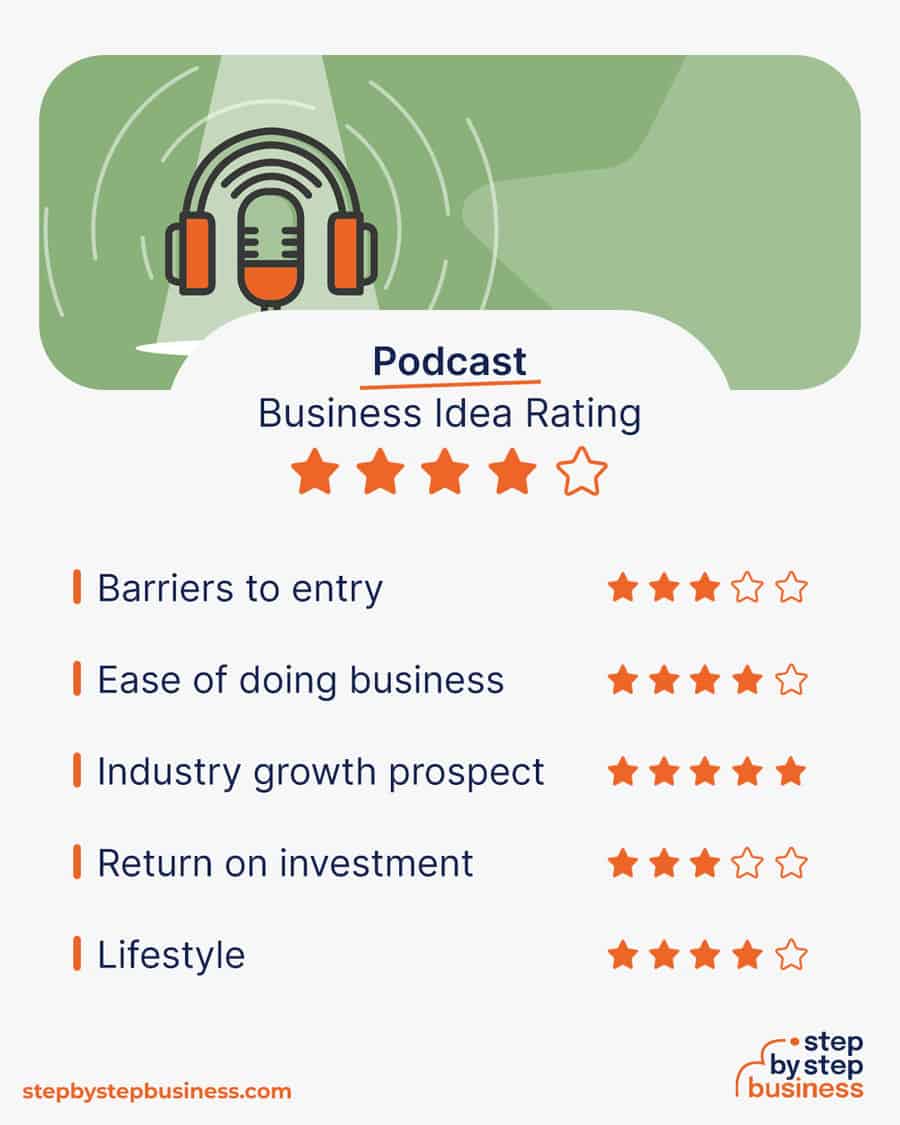

Since your podcast is going to be a business, you’ll also need a business name. Your business name is your business identity, so choose one that encapsulates your objectives, services, and mission in just a few words. You probably want a name that’s short and easy to remember, since much of your business, and your initial business in particular, will come from word-of-mouth referrals.
Here are some ideas for brainstorming your business name:
Once you’ve got a list of potential names, visit the website of the US Patent and Trademark Office to make sure they are available for registration and check the availability of related domain names using our Domain Name Search tool. Using “.com” or “.org” sharply increases credibility, so it’s best to focus on these.
Finally, make your choice among the names that pass this screening and go ahead with domain registration and social media account creation. Your business name is one of the key differentiators that sets your business apart. Once you pick your company name, and start with the branding, it is hard to change the business name. Therefore, it’s important to carefully consider your choice before you start a business entity.
Every business needs a plan. This will function as a guidebook to take your startup through the launch process and maintain focus on your key goals. A business plan also enables potential partners and investors to better understand your company and its vision:
If you’ve never created a business plan, it can be an intimidating task. You might consider hiring a business plan specialist at Fiverr to create a top-notch business plan for you.

Registering your business is an absolutely crucial step — it’s the prerequisite to paying taxes, raising capital, opening a bank account, and other guideposts on the road to getting a business up and running.
Plus, registration is exciting because it makes the entire process official. Once it’s complete, you’ll have your own business!
Your business location is important because it can affect taxes, legal requirements, and revenue. Most people will register their business in the state where they live, but if you’re planning to expand, you might consider looking elsewhere, as some states could offer real advantages when it comes to podcasts.
If you’re willing to move, you could really maximize your business! Keep in mind, it’s relatively easy to transfer your business to another state.
Business entities come in several varieties, each with its pros and cons. The legal structure you choose for your podcast business will shape your taxes, personal liability, and business registration requirements, so choose wisely.
Here are the main options:
We recommend that new business owners choose LLC as it offers liability protection and pass-through taxation while being simpler to form than a corporation. You can form an LLC in as little as five minutes using ZenBusiness’s online LLC formation service. They will check that your business name is available before filing, submit your articles of organization, and answer any questions you might have.

The final step before you’re able to pay taxes is getting an Employer Identification Number, or EIN. You can file for your EIN online or by mail or fax: visit the IRS website to learn more. Keep in mind, if you’ve chosen to be a sole proprietorship you can simply use your social security number as your EIN.
Once you have your EIN, you’ll need to choose your tax year. Financially speaking, your business will operate in a calendar year (January–December) or a fiscal year, a 12-month period that can start in any month. This will determine your tax cycle, while your business structure will determine which taxes you’ll pay.
The IRS website also offers a tax-payers checklist, and taxes can be filed online.
It is important to consult an accountant or other professional to help you with your taxes to ensure you’re completing them correctly.
Securing financing is your next step and there are plenty of ways to raise capital:
Bank and SBA loans are probably the best option, other than friends and family, for funding a podcast business. You might also try crowdfunding if you have an innovative concept.


Starting a podcast business requires obtaining a number of licenses and permits from local, state, and federal governments.
Federal regulations, licenses, and permits associated with starting your business include doing business as (DBA), health licenses and permits from the Occupational Safety and Health Administration (OSHA), trademarks, copyrights, patents, and other intellectual properties, as well as industry-specific licenses and permits.
You may also need state-level and local county or city-based licenses and permits. The license requirements and how to obtain them vary, so check the websites of your state, city, and county governments or contact the appropriate person to learn more.
You could also check this SBA guide for your state’s requirements, but we recommend using MyCorporation’s Business License Compliance Package. They will research the exact forms you need for your business and state and provide them to ensure you’re fully compliant.
This is not a step to be taken lightly, as failing to comply with legal requirements can result in hefty penalties.
If you feel overwhelmed by this step or don’t know how to begin, it might be a good idea to hire a professional to help you check all the legal boxes.
Before you start making money, you’ll need a place to keep it, and that requires opening a bank account.
Keeping your business finances separate from your personal account makes it easy to file taxes and track your company’s income, so it’s worth doing even if you’re running your podcast business as a sole proprietorship. Opening a business bank account is quite simple, and similar to opening a personal one. Most major banks offer accounts tailored for businesses — just inquire at your preferred bank to learn about their rates and features.
Banks vary in terms of offerings, so it’s a good idea to examine your options and select the best plan for you. Once you choose your bank, bring in your EIN (or Social Security Number if you decide on a sole proprietorship), articles of incorporation, and other legal documents and open your new account.
Business insurance is an area that often gets overlooked yet it can be vital to your success as an entrepreneur. Insurance protects you from unexpected events that can have a devastating impact on your business.
Here are some types of insurance to consider:


As opening day nears, prepare for launch by reviewing and improving some key elements of your business.
Being an entrepreneur often means wearing many hats, from marketing to sales to accounting, which can be overwhelming. Fortunately, many websites and digital tools are available to help simplify many business tasks.
You may want to use industry-specific software, such as Process Street, to manage your episodes, publishing workflows, and task checklists.
Again, for recording and editing your podcasts, you can use software such as Riverside, Restream, and Zencastr.
Some of your business will come from casual online visitors, but you should still invest in digital marketing! Getting the word out is especially important for new businesses, as it’ll boost customer and brand awareness.
Once your website is up and running, link it to your social media accounts and vice versa. Social media is a great tool for promoting your business because you can create engaging posts that advertise your products:
Take advantage of your website, social media presence, and real-life activities to increase awareness of your offerings and build your brand. Some suggestions include:
Website development is crucial because your site is your online presence and needs to convince prospective clients of your expertise and professionalism. They are unlikely to find your website, however, unless you follow Search Engine Optimization (SEO) practices. These are steps that help pages rank higher in the results of top search engines like Google.
You can create your own website using services like WordPress, Wix, or Squarespace. This route is very affordable, but figuring out how to build a website can be time-consuming. If you lack tech-savvy, you can hire a web designer or developer to create a custom website for your business.
Unique selling propositions, or USPs, are the characteristics of a product or service that set it apart from the competition. Customers today are inundated with buying options, so you’ll have a real advantage if they are able to quickly grasp how your podcast meets their needs or wishes. It’s wise to do all you can to ensure your USPs stand out on your website and in your marketing and promotional materials, stimulating buyer desire.
Global pizza chain Domino’s is renowned for its USP: “Hot pizza in 30 minutes or less, guaranteed.” Signature USPs for your podcast business could be:

You may not like to network or use personal connections for business gain. But your personal and professional networks likely offer considerable untapped business potential. Maybe that Facebook friend you met in college is now running a podcast business, or a LinkedIn contact of yours is connected to dozens of potential clients. Maybe your cousin or neighbor has been working in podcasts for years and can offer invaluable insight and industry connections.
The possibilities are endless, so it’s a good idea to review your personal and professional networks and reach out to those with possible links to or interest in podcasts. You’ll probably generate new customers or find companies with which you could establish a partnership.

If you’re starting out small from a home office, you may not need any employees. But as your business grows, you will likely need workers to fill various roles. Potential positions for a podcast business include:
At some point, you may need to hire all of these positions or simply a few, depending on the size and needs of your business. You might also hire multiple workers for a single role or a single worker for multiple roles, again depending on need.
Free-of-charge methods to recruit employees include posting ads on popular platforms such as LinkedIn, Facebook, or Jobs.com. You might also consider a premium recruitment option, such as advertising on Indeed, Glassdoor, or ZipRecruiter. Further, if you have the resources, you could consider hiring a recruitment agency to help you find talent.

Podcasts are all the rage, with all kinds of people listening and creating them for fun or business. In a few years, it’s anticipated that 160 million Americans will be listeners. If you have an innovative concept for a podcast or valuable information you want to share, you could ride the podcast wave to serious success!
You know what to do now, so it’s time to hit the record button and get your successful podcast started.
You can start a podcast for about $3,500. You just need a computer, some recording equipment, and recording and editing software. You’ll also need an appealing concept.
You can make money from a podcast through affiliate relationships, advertising, and even selling merchandise. You’ll just have to get a large following to achieve profitability.
You may need various business licenses and permits at the state and local levels. Check with your local governments for requirements or visit MyCorporation’s Business License Compliance page.

Published on August 16, 2023
Find aDomain Search Powered byGoDaddy.com ...
Read Now

Published on March 16, 2023
Lorem ipsum dolor sit amet, consectetur adipiscing elit, sed do eiusmod tempor incididunt ut labore et dolore magna aliqua. Ut enim ad minim veniam, ...
Read Now

Published on March 10, 2023
When to Use Paychex Flex When to Use QuickBooks Payroll ...
Read Now
No thanks, I don't want to stay up to date on industry trends and news.
Comments